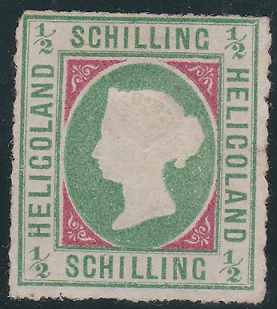Introduction to Heligoland’s Postal History
Heligoland, a small island in the North Sea, was ceded to Great Britain through the Treaty of Kiel on January 14, 1814. Despite this, the postal service on the island continued to be managed by the Free City of Hamburg. Until July 1, 1866, mail sent from Heligoland bore Hamburg stamps, which were cancelled upon arrival in Hamburg. However, after this date and up to March 20, 1867, mail from Heligoland began receiving a distinct cancellation—a British-style double-circle handstamp marked with “HELIGOLAND.”
The Printing of Heligoland Stamps
All stamps issued for Heligoland were printed at the Imperial Printing Works in Berlin. These stamps became notable for their vibrant colours, unique designs, and later, for the numerous reprints that collectors often encounter.
Reprints and Forgeries: A Significant Challenge for Collectors
Heligoland stamps saw multiple reprintings from various locations over the years, complicating the identification of genuine issues.
Locations and Timeframes of Reprints
- Berlin (Between 1875 and 1885)
- Leipzig (1888)
- Hamburg (1892 and 1895)
Among these, only the Berlin printings are difficult to distinguish from the originals, necessitating detailed notes for individual stamps. Leipzig reprints are identifiable by their highly surfaced paper, while Hamburg reprints can be distinguished by their perforation of 14.
German Government Reprint of 1890
In addition to the commercial reprints, the German government produced a small reprinting in 1890. These stamps were meant for exchange purposes and are significantly rarer than the original issues.
Forgeries
Apart from reprints, Heligoland stamps were heavily forged. Many counterfeits were produced using lithography instead of typography. The most commonly forged stamps include:
- Nos. 1/4, 6, and 8, often seen with perforations of 12½ or 13.
- Some forgeries also feature fake cancellations, making it crucial for collectors to verify authenticity before making purchases.
Heligoland’s Embossed Stamps: The 1867-1868 Issues
One of the most remarkable aspects of Heligoland’s philatelic history is its embossed stamps featuring Queen Victoria’s profile. These stamps were introduced in 1867 and produced in various color combinations. The embossing method created a raised relief effect, adding to their visual appeal.
Die Variations for the Embossed Head
Heligoland stamps with embossed profiles were issued in three distinct die types:

Die I
-
- Recognizable by a blob instead of a curl beneath the chignon.
- The outline of two jewels at the top of the diadem.

Die II
-
- Displays a curl under the chignon.
- Features one jewel at the top of the diadem.

Die III
-
- Has a shorter curl under the chignon.
- Includes two jewels at the top of the diadem.
These dies are crucial in identifying variations between different issues.
1867 (March 21) Issue – Embossed Head in Colourless Relief
- ½ schilling, blue-green and rose – Original price: £350 mint, £950 used.
- 1 schilling, rose and blue-green – £190 mint, £225 used.
- 2 schilling, rose and grass-green – £20 mint, £65 used.
- 6 schilling, green and rose – £22 mint, £325 used.
Identifying Reprints of the 1867 Issue
- ½ schilling reprints appear in a yellowish-green shade and always feature Head Die II.
- 1 schilling reprints are only found in Head Die III.
- 2 schilling reprints exhibit a dull rose shade with a deeper blue-green.
- 6 schilling reprints differ in the shade of green, with originals displaying white specks, while Berlin reprints have a more uniform bluish-green.
The 1869-1873 Issue – Head Embossed in Colourless Relief
Following the earlier releases, Heligoland continued issuing embossed stamps, but with more variations in perforation and background designs.
April 1869 Issue
-
¼ schilling, rose and green (Die I, quadrillé paper) – £35 mint, £1,800 used.
- Error variant (Green and Rose Background, 9.73) – £225 mint, £3,250 used.
- Deep Rose and Pale Green Background (11.73) – £95 mint, £1,800 used.
-
½ schilling, blue-green and rose (Die II) – £250 mint, £950 used.
- Yellow-Green and Rose (7.71) – £250 mint, £950 used.
- Quadrillé Paper Variant (6.73) – £100 mint, £2,000 used.
-
¾ schilling, green and rose (Die I, quadrillé paper, 12.73) – £50 mint, £1,800 used.
-
1 schilling, rose and yellow-green (Die III) – £200 mint, £250 used.
- Quadrillé Paper Variant (Rose and Pale Blue-Green, 6.73) – £180 mint, £2,500 used.
-
1½ schilling, green and rose (Die I, quadrillé paper, 9.73) – £95 mint, £300 used.
Identifying Reprints of the 1869-73 Issue
- ¼ schilling reprints – Mostly Berlin and some Hamburg, all of which feature Head Die II.
- ½ schilling reprints – Found on thinner paper with solid green in the spandrels.
- ¾ schilling reprints – Printed on thinner, non-quadrillé paper.
- 1 schilling reprints – Typically printed on thinner paper with breaks in the rose line beneath “SCHILLING”.
- 1½ schilling reprints – All Berlin and some Hamburg reprints use Head Die II.
Additionally, Leipzig and Hamburg reprints exist for the 2 schilling and 6 schilling values, but these do not come in perforated originals.
Conclusion: A Collector’s Perspective on Heligoland Stamps
Heligoland’s postage stamps offer an exciting yet complex field for collectors. With their vivid designs, embossed profiles, and multiple printings, these stamps provide a window into the postal history of a once-British island that later became part of Germany.
Given the large number of reprints and forgeries, collectors must exercise caution when purchasing Heligoland stamps. Authentication by an expert, familiarity with die types and printing variations, and knowledge of common forgery characteristics can help ensure a genuine and valuable collection.
These historical artifacts remain a cherished part of philately, and their scarcity, particularly in used condition, continues to drive demand among serious collectors.


